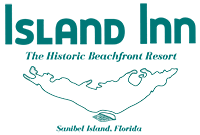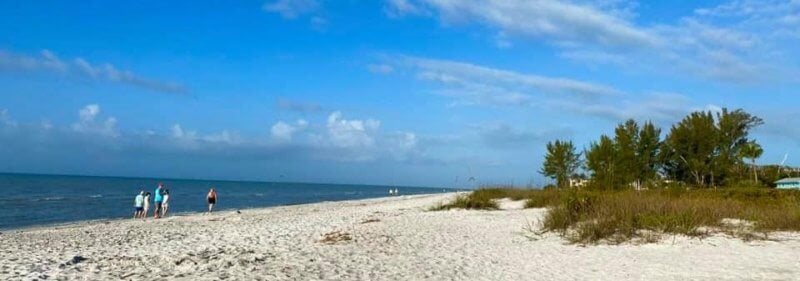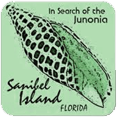
The Islands of Sanibel and Captiva were formed by the prevailing currents in the Gulf of Mexico about 6,000 years ago. This makes them infants geologically: Egyptian civilization was well underway before the islands even existed let alone were habitable. The pyramids of Giza were being built just at the time that the islands were settling into the shape that we know today. The islands began as one but have been frequently separated by the storms that affect the whole of the Gulf. Blind Pass between the two was closed as recently as two years ago and has to be maintained regularly to ensure the free passage of water between Bay and Gulf.
The first humans in the general area were the Calusa, who arrived about 2,500 years ago. They were a significant Indian tribe who came to dominate a large part of Southwest Florida through trade and an elaborate system of canals and waterways built by them. Sanibel remained an important Calusa settlement until the collapse of their rule soon after the arrival of the first Europeans in the mid-16th century.
The first appearance of a harbor on Sanibel appears on a map of 1765: listed as Puerto de S. Nivel or Nibel. An official Spanish map of 1768 identifies the whole island by the same name and this seems most likely to be the origin of Sanibel. Experts think that the port was named by Juan Ponce de León after Queen Isabella I of Castile. He had attempted to settle on the island in June 1513 but was chased off by the Calusa Indians who remained the only inhabitants on the island until the arrival of the Spanish.
Florida, including Sanibel, was a possession of Spain until it was traded to Britain in exchange for Cuba in 1763. The previous half century had seen frequent battles between the British and the Spanish over Florida settlements: the British had captured Havana in 1762, but preferred Florida because of the proximity of the British colonies to the north. Thus ended some 250 years of Spanish rule.
The first modern settlement on Sanibel was established by the Florida Peninsular Land Company in 1832. The Company began marketing Sanibel as a planned community that would “become the garden of Florida”. It was said to have streams of fresh water, be high and dry almost eight feet above high tide and constantly refreshed with sea breezes. The East End of the island was plotted into 50 homesites (along with a town center) and the rest of the island was divided into 50 parallel tracts which ran from Gulf to bay.
A few pioneers began planting sugar cane, pineapple, pumpkins, melons, sisal and hemp (both used in the making of rope, hammocks and nets) and corn. Fish houses and drying sheds were built in the bay and near the mouth of the “Caloosa Hatchee” river. Unfortunately for the farmers the U.S. government ordered them to abandon their farms fearing that they might support the few remaining Indians when the government was forcing them to migrate west. The settlement did not survive and was abandoned by 1849, but it did petition for a lighthouse on the island. The Homestead Act of 1862 encouraged the repopulation of the island and by 1884 the Sanibel Island Lighthouse was completed. One of the reasons for the lighthouse was increased traffic in and out of Punta Rassa Harbor much of which was cattle steamers going to and from Cuba. At the same time the Inter-Ocean Telegraph Company of Newark, New Jersey took over the abandoned barracks of an old Fort (Fort Dulaney) located at Punta Rassa as a base to string telegraph lines throughout Florida. The lighthouse was first lit on August 20, 1885. Together with the light house keeper buildings it is on the National Register of Historic Places and the complex is the oldest structure on Sanibel. Ten years later, in 1895 the Island Inn was built by the Matthews family and is the oldest Inn on Sanibel. For over 117 years it has served guests and residents in its magnificent site on ten acres of pristine private beach, virgin dune and silky sand: facing due south on the Gulf of Mexico.
Many arrivals on Sanibel turned to farming and in particular tomato growing. With a nine month growing season, October to June, tomatoes became a huge export from Sanibel. By boat and train they were taken to cities throughout the East. Unfortunately a hurricane in 1926 covered the island with salt water and destroyed the soil for farming.
In the thirties sport fishing became popular and to some extent replaced farming. Some of the greatest Tarpon fishing is just off shore from Sanibel. Tarpon had regularly been caught with shark hooks tipped with bait but the first tarpon caught with rod and reel was taken in San Carlos Bay. With the shallow waters surrounding the island, shore fishing, sunbathing, playing in the sand and shelling grew to become very popular. Both tarpon tales and shelling tales gradually spread to the wider world. Sanibel beaches were strewn with shells never before seen and visitors spent many hours looking for choice specimens. The abundance of shells had led the Calusa’s to create shell mounds as burial places many of which are still visible today.
By the early 1900′s Sanibel was on its way to being a prime destination for vacationers: wealthy families from the North East. The island became known as a wholesome, family place. This was a very proper era when ladies wore dresses and gentleman wore jackets and tie even strolling on the beach.
In 1928 a ferry service began to and from the mainland. On June 25, 1928 the first Kinzie Ferry sailed from Punta Rassa to Sanibel. It carried not only visitors but their horseless carriages which were often seen driving on the beaches. Henry Ford and Thomas Edison visited the island regularly looking for new plant species and shells for study and identification.
The depression era and WWII led to a long period of inactivity that did not end until the late forties when visitors to Sanibel began to come in even greater numbers. More inns opened and guests were greeted at the ferry landing with brochures for island accommodations. A larger ferry was introduced and seaplanes transported visitors from Page Field to a landing strip across from Casa Ybel; now the Butterknife subdivision.
Jay Norwood, “Ding” Darling, a Pulitzer Prize winning political cartoonist with an eye toward conservation, made nearby Captiva Island a regular winter retreat spot. He campaigned for the protection of the islands’ fragile wetlands and his efforts blocked the sale of a parcel of environmentally valuable Sanibel land to developers. At Darling’s urging, President Harry S. Truman signed an Executive Order creating the Sanibel National Wildlife Refuge in 1945: a refuge that occupies more than half of Sanibel Island. It was renamed in 1967 in honor of the pioneer conservationist and now consists of over 6,400 acres of mangrove forest, submerged seagrass beds, cordgrass marshes, and West Indian hardwood hammocks. Some 2,800 acres of the refuge are designated by Congress as a Wilderness Area.
In May 1963 a causeway linking Sanibel and Captiva to the mainland was opened. The resulting explosion of growth led to islanders incorporating the City of Sanibel in order to control development in the interests of wildlife, the natural beauty of the island and residents. The original causeway was replaced in 2007; and features a “flyover” span tall enough for sailboats to pass under, replacing the old bridge’s bascule drawbridge span. Sanibel today retains the charm and natural beauty that has always characterized the island and creates a backdrop of nature’s unspoiled and enduring creations to frame the modern amenities of the hotels and resorts along the Gulf coast. They provide the comfortable accommodation and easy access to the island’s attractions enjoyed annually by visitors and residents.
Sanibel is one of the few barrier islands with an east-west orientation: most are north-south. Hence, the island is gifted with great sandy beaches, facing due south and south west for 17 miles along the Gulf of Mexico. The beaches are ungroomed: nature is allowed to roam freely along them and hence the abundance of bird and other wild life: of shore line vegetation and the small creatures for whom this is their natural habitat. Up to 200 yards wide at low tide, the beaches also offer unrivalled space for families, walkers and fishermen to enjoy a climate that welcomes them to the pleasures of sun, sand and sea throughout the year.
FOR MORE INFORMATION:
The City of Sanibel partnered with WGCU Public Media to produce a 4 part video about Sanibel Island.
View the series here- “Untold Stories of Southwest Florida”
Visit the Sanibel Historical Museum and Village
950 Dunlop Road – tel: (239) 472-4648
This collection of late 19th- and early 20th-century buildings brings early Sanibel back to life and includes the island’s original schoolhouse.
Visit the Sanibel public library
770 Dunlop Rd – tel: (239) 472 2483
The library was named as a 5-Star Library in the Library Journal annual America’s Star Libraries 2011 survey and the 2012 Best Library in Florida Weekly.
Sanibel Island Historic Timeline
- Around 6000 BC – Sanibel & Captiva Island formed by Gulf currents
- Around 500 BC – Sanibel Island inhabited by the Calusa Indians
- 1513 – Ponce de Leon lands on and names Sanibel
- 1520 – 1763 Florida is Spanish
- 1763 – Florida becomes British and is named the Province of West Florida with George Johnstone the first royal governor and Pensacola the seat of government.
- 1765 – Sanibel’s first recorded harbor at the east end of the Island
- 1795 – The Pinckney Treaty settles the southern boundary of the United States and includes Florida.
- 1884 – Sanibel’s Island lighthouse is completed and becomes the first lighthouse on Florida’s gulf coast: first illuminated on August 20th
- 1895 – the Matthews family builds the Island Inn
- 1901 – the Chapel by the Sea on Captiva was built
- 1945 – Sanibel wildlife refuge, later Ding Darling, is created
- 1963 – the Causeway linking Sanibel and the mainland is completed: rebuilt in 2007



